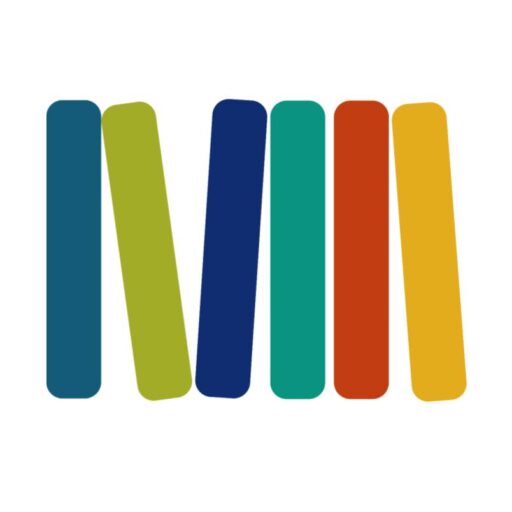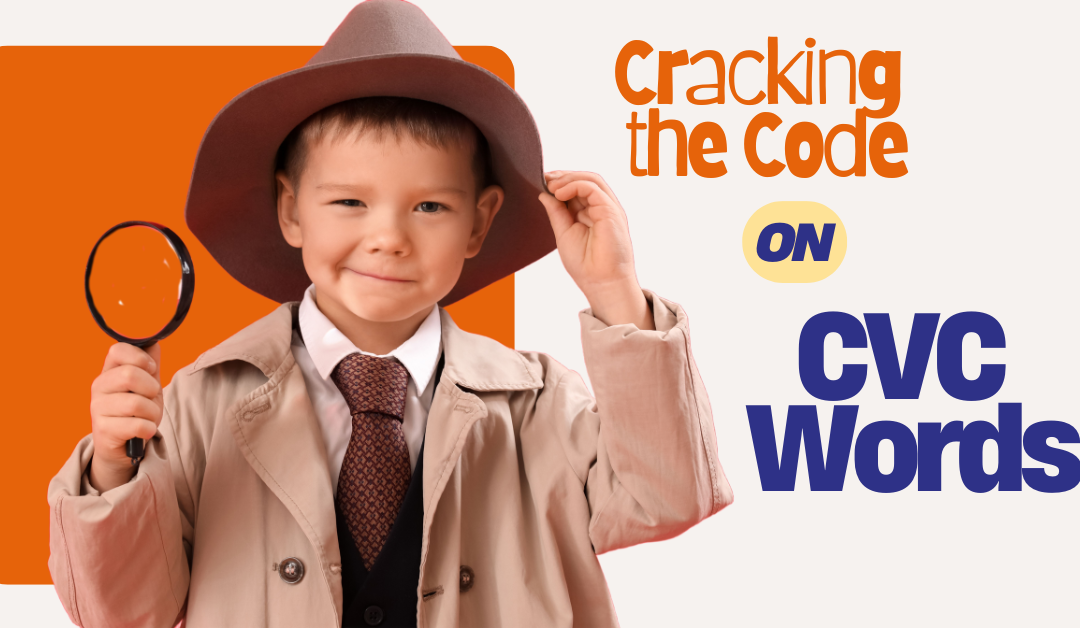You don’t have to dip your toe very far into the early literacy pond to encounter CVC words. From posters to games to phonics lessons—these short and SNAP-py words seem to POP up everywhere—and for good reason! CVC words are more than just a starting point for literacy; they’re a gateway to unlocking reading and writing confidence.
But why are these simple little words such a big deal? And how do they fit into the bigger picture of learning to read?
Let’s take a closer look at these foundational words and uncover what makes them such an important stepping stone in every beginning reader’s journey.
What Are CVC Words?
For example, the greeting, hi, is an open syllable; it doesn’t have a consonant sound closing in the vowel, so the vowel is considered a “long” vowel sound, a vowel that says its name. But add the consonant letter “P” after the vowel sound, and the letter “I” changes from representing a long vowel sound to representing a short one. Now we’ve got the word hip, a term popularized in the 60s to describe being on trend, but that also means the part of our bodies that can start to complain after sitting at a computer too long. (Aren’t words fun?)
CVC Words: How Do They Help Readers?
For beginning readers, the beauty of CVC words is in their simplicity. With only three sounds represented by just as many spellings—a beginning (consonant), a middle (vowel), and an ending (consonant)—CVC words give children a chance to practice blending just enough individual sounds (phonemes) to read whole words without overloading their working memory.
These early encounters with CVC words provide building blocks for understanding how written language works, but their magic doesn’t stop there. Practicing CVC words builds confidence and decoding skills during a phase in reading development when the reading brain is just beginning to understand what the alphabetic system is all about. These reliable CVC words help reinforce the alphabetic principle, teaching students they can rely on sound-spellings to access the words these letter strings represent.
But beginning readers aren’t the only ones who benefit from CVC word practice. We don’t learn CVC words and then move past them. We actually use them to read longer, more challenging words, as well.
You see, CVC words are referred to as closed syllables because they aren’t just words—they are also syllables that frequently make up bigger words. In fact, CVC syllables are the most common syllable type in English. So, not only are there scads of simple CVC words in our language, but there are also oodles of longer words that include one or more closed syllables—words like mag-net, sub-mit, dis-con-tent, mis-con-duct. So, mastering closed syllables in their simplest form (CVC words) is an important step toward eventually decoding longer, multisyllabic words. In fact, without lots of practice and success with simple CVC words, it becomes almost impossible for students to begin reading multisyllabic words.
Take the word fantastic: It’s made up of three closed syllables (fan-tas-tic). A child who understands the patterns and rules of closed syllables will have the prerequisite skills they need to break down these longer words with relative ease. In other words, building confidence with CVC, CCVC, and CVCC words early on creates a ripple effect for future success.
CVC Word Practice: Stretching Into More Challenging Words
CVC words aren’t the only closed syllables that are important for students to learn how to read and write. Once students get the hang of basic CVC words, they’re ready to meet CVC‘s cousins—VC, CCVC, CVCC, and CCVCC, not to mention closed syllables with digraphs at the beginning or end. Introducing these more complex challenges thoughtfully and gradually will support students to stretch and evolve as confident decoders and spellers.
VC Words
Words like at, if, and on are examples of closed syllable words that begin with vowels instead of consonants. Although these little words are even littler yet, the fact that they begin with a sometimes-tricker-to-master vowel sound rather than an often-easier-to-master consonant sound can make them a bit more challenging for some children.
CVC Words (with Digraphs)
Words like fish, chip, and path feature digraphs—two letters that combine to make one sound—within a closed syllable. Here’s a fun fact: Even though consonant digraphs like sh, ch, or th are made of two letters, they represent a single sound. Therefore, these words are still considered CVC words in phonics notation.
CCVC Words (Beginning Blends)
Words like frog, trap, and clam add a consonant blend at the beginning of a closed syllable. These blends involve two consonants working together, but each keeps its own sound (e.g., fr in frog), and that’s why two initial CCs are used in the notation. These words can be particularly challenging for students to spell because the internal consonant in the initial blend is one of the hardest for the listening ear to isolate in words.
CVCC Words (Ending Blends)
Words like desk, hunt, and lamp introduce consonant blends at the end of a closed syllable. These words give students practice with hearing and decoding multiple sounds at the word’s finish. Once again, these words can be tricky because the internal consonant—now second from the end of the word—can also be hard for their ears to distinguish.
CCVCC Words (Beginning and Ending Blends)
Words like trunk, brisk, and frost offer beginning readers the chance to get comfortable with those tricky interior consonants at both the beginning and the end of the closed syllable. Once they’ve mastered simpler words, these words can be blending practice treasures!
Whether the next step after simple CVC words is consonant blends or consonant digraphs depends on your scope and sequence, and no single sequence is inherently superior. However, it’s important to understand the difference: reading words with consonant blends requires students to decode and blend additional sounds, while introducing consonant digraphs involves a new concept. Digraphs teach students that two letters can work together to represent a single sound—something quite different from what they’ve learned to expect from each letter individually.
Balancing Decoding With Encoding
Decoding and encoding are two sides of the same coin, and both are essential for developing strong early literacy skills. While decoding (combining individual sounds to form spoken words) is often emphasized in phonics instruction, encoding (recording the spelling for individual sounds in words) is equally important, if not more so, for building spelling skills.
With CVC words, students can practice decoding written sound symbols like /s/ /a/ /p/ into sap, then reverse the process by segmenting the spoken word sap into /s/ /a/ /p/ and recording the spellings for each sound.
Encoding often gets less attention than decoding but is critical to help students become confident spellers because it trains them to hear and record each sound in a word. A balanced approach to teaching CVC words should include ample practice with both skills, ensuring students can seamlessly move between decoding and encoding.
A Word of Caution: Meaning Matters
While loads of practice with simple closed-syllable words is vital, it’s easy to fall into the trap of isolated drills that don’t make much connection to meaning. But, you might find it surprising to realize how many CVC words have meanings (or multiple meanings) unfamiliar to many children.
Sure, kids might be able to decode words like cog, vat, and mend. But will they understand these words if they hear them in conversation or encounter them in a text? And does that really even matter?
The short answer is yes, it does matter.
Since decoding is about translating written symbols into words that can be found in the brain’s mental dictionary, having the word in that mental dictionary to begin with is an obvious advantage. We all know that decoding is in service of the ultimate goal of reading comprehension. But connecting decoding work to meaning in the moment is a big deal.
Giving students opportunities to connect words with meaning, and hear or use them in context, makes decoding and spelling practice more meaningful today, but it can also make decoding and comprehending better down the road. So, for example, if children can see engaging images that illustrate words like cog, or vat, or mend, and if they can engage in playful interactive work with them—deepening their understanding of meaning, context, phonology, and spelling—then we engage all four parts of their four-part processing systems. In this way, we can leverage important pieces of both the science of learning and the science of reading, bringing word reading and language comprehension together. Win-win!
CVC Word Practice: A More Meaning-FULL Approach
We know you are committed to helping children develop skills for both reading words and comprehending meaning. No one wants children to become word-callers! And we know many early literacy teachers are on the lookout for resources to make early decoding and encoding practice more meaningful, engaging, and effective.
This is what we had in mind when we designed Blending Magic—a supplemental resource intentionally crafted to weave phonics practice into rich, meaningful activities that not only build decoding and encoding skills but also enhance vocabulary and oral language development. With Blending Magic, students engage in decoding and encoding while simultaneously connecting to known words and discovering new and interesting vocabulary. Our goal was to ensure that phonics practice is not only effective but also engaging and deeply integrated with language development to support robust literacy growth.
Teaching CVC Words: Tips to Keep in Mind
You don’t need a purchased resource to provide effective CVC practice. Here are some tips to keep in mind with any plan for instruction:
A Better Way to Practice Closed Syllables
1. Move From Sound-Spellings to Word-Reading ASAP
Children don’t need to know ALL the letter names and sounds to begin reading actual words. With knowledge of just a single short vowel sound and a few consonants, children can take their literacy learning from knowing isolated sound-spellings to reading and writing whole words.
2. Start Simple, Build Slowly
Begin with the simplest VC and CVC words. Then, gradually introduce students to more challenges by introducing CCVC, CVCC, and CCVCC words to the mix (at, cat, chat, math, clap, camp, clasp). Along the way, be sure to use accurate academic language to explain patterns (consonant, vowel, blend, digraph, etc).
3. Don’t Neglect the Encoding
Remember to include just as much opportunity for students to segment sounds and encode (write the sounds) as for students to blend and decode (read the sounds).
4. Keep Instruction Multi-Sensory and Fun
Use whiteboards, letter tiles, blending boards, and sky writing. Use gestures and visuals. A few visual and/or kinesthetic touches can go a long way in keeping young learners engaged with content that is tricky for the brain to master.
5. Build Vocabulary Alongside Phonics
When encountering new words, like sap or vat, offer simple definitions and demonstrate the use of the words in context. Then, encourage students to take them for a test drive, using them in their own sentences or stories. For example, ask, “What might trap a frog? How would he get out?”
6. Spotlight Multiple Meaning Words
The English language is full of multiple-meaning words, and many of them are simple, closed-syllable words. Be on the lookout for (and spotlight) CVC words with multiple meanings.
7. Use Formative Assessment
Regularly assess students with a simple 2-4 word spelling dictation to quickly gauge their ability to show what they know about the patterns you’ve taught and to identify who needs additional practice.
8. Provide Cumulative and Consistent Practice
Be consistent with practice opportunities to stabilize new skills and maintain past skills. Practice with reading and writing; using a mix of word-level, sentence-level, and longer decodable texts is ideal.
9. Celebrate Milestones
When students master all five short vowels or tackle their first CCVC word, celebrate! These moments build their confidence and motivate them to keep going. Every step, from blending a simple word like cat, to tackling words with blends and digraphs like crunch, is a victory. Let your students know how far they’ve come and how these skills will unlock even bigger adventures in reading.
Teaching closed syllables takes time, patience, and intentional instruction, but the payoff is huge. When students can confidently read and write CVC, CCVC, and CVCC words, they’re not just mastering little words—they’re building a toolkit they’ll use for years to come. And when they start breaking down multisyllabic words like magnetism or athletic, you’ll know you’ve given them a gift that keeps on giving.
If the descriptions of Blending Magic piqued your curiosity and you’re looking for smart ways to supplement your CVC word reading and writing practice, Blending Magic might be just what you need!
In Blending Magic, we’ve done the heavy lifting for you by creating blending lines and related sentences, complemented by beautiful, conversation-worthy photos to make the practice both effective and engaging. Each short vowel sound is supported with five practice sets, and every set includes multiple resources:
- Interactive slideshows for teacher-guided instruction
- Student printable one-pagers
- Student books
- Game cards
These resources are thoughtfully designed to provide a variety of ways to practice and reinforce skills while keeping students engaged.
You can learn more about Blending Magic here and even download a free sample to try with your students right away. Give it a try and see how it transforms your phonics practice into a meaningful, effective, and fun experience!
But, whether you gather resources and do the work yourself or you take a Blending Magic shortcut, the effort to make decoding and spelling closed-syllable words more meaningful and effective is definitely a worthwhile investment. Supporting students in building these foundational skills through engaging and purposeful practice lays the groundwork for confident, capable readers and writers.
The Opportunity to Build a Bridge to Lifelong Literacy
CVC words are just the starting point on the road to reading and writing, but they lay the groundwork for everything that follows.
With a bit of creativity, consistent practice, and tools like Blending Magic, you can make decoding and spelling practice more meaning-FULL and have some fun along the way! When the foundation is strong, the possibilities are truly endless.
Mastering closed syllables isn’t just a milestone; it’s a key that opens the door to a world of words. By teaching early decoding and spelling skills with purpose, meaning, and a touch of joy, you’ll empower your students to become confident, capable readers—ready to tackle whatever comes next on their literacy journey.
Get your free sample of Blending Magic today!
-

Jan Burkins and Kari Yates are authors, speakers, and consultants, who are dedicated to helping teachers around the world translate reading science into simple instructional moves that help teachers make learning to read easier for their students while still centering meaning-making, engagement, and joy.
Recent Posts



I am intersted in trying this but was wondering how to get the free sample?
Go to BlendingMagic.com. At the bottom of the page you should see button that says, “Get one set free.” Download and have some fun! Let us know what you think!
Is this program all digital, or are there some printables.
Robin,
Great question. The student one-pagers, student Magic Books, and game cards are all printable PDFs. The only component that is not printable is the interactive slide show.
Be sure to download the free sample so you can see how each component works!
Jan and Kari
I have purchased the subscription but am unable to find the PDF of the Blending Magic dictation
page. Could you direct me to where that might be? Thank you so much!
Hi Carrie,
We’d be happy to get you that PDF and answer any other questions. Please email CustomerService@TheSixShifts.com.